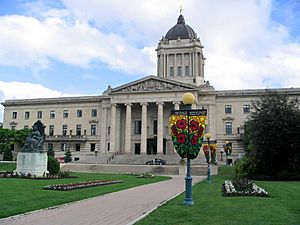Manitoba Legislature facts for kids
Quick facts for kids Manitoba LegislatureLégislature du Manitoba |
|
|---|---|
| 41st Manitoba Legislature | |
| Type | |
| Type |
Bicameral (1870–1876)
Unicameral (1876–) |
| Houses | Legislative Council (until 1876) Legislative Assembly |
| History | |
| Founded | 1870 |
| Meeting place | |
 |
|
| Manitoba Legislative Building, Winnipeg, Manitoba | |
The Legislature of Manitoba is the main law-making group for the province of Manitoba, Canada. It's where important decisions are made and laws are created for everyone living in Manitoba.
Today, the Legislature has two key parts. First, there's the Queen of Canada, who is represented in Manitoba by the Lieutenant Governor of Manitoba. Think of the Lieutenant Governor as the Queen's representative in the province. The second part is the Legislative Assembly of Manitoba. This assembly is "unicameral," which means it has only one group of elected members.
The Legislature has been around since 1870. That's when Manitoba officially became a province, created from a part of a large area called Rupert's Land.
Contents
How Manitoba's Government Works
Manitoba uses a special way of governing called the Westminster-style parliamentary government. This system is similar to how the Canadian federal government works, and it's based on the way the government runs in the United Kingdom.
In this system, people vote in general elections to choose who will represent them. These chosen people become members of the Legislative Assembly. The political party that wins the most seats in the assembly then gets to choose a leader. This leader becomes the Premier of Manitoba.
Roles of the Premier and Queen
The Premier acts as Manitoba's head of government. This means they are in charge of running the province day-to-day. The Queen of Canada, on the other hand, acts as the province's head of state. This is a more symbolic role, representing the province and its people.
A Look Back: The Early Days
When Manitoba's Legislature first started in 1870, it was "bicameral." This means it had two separate groups or "houses" that worked together. One was the Legislative Assembly, and the other was called the Legislative Council of Manitoba.
Why the Legislative Council Was Removed
However, the Legislative Council didn't last very long. It was removed in 1876. This happened because the government wanted to save money. Also, the federal government made it a condition for giving Manitoba more funding. So, the Legislature became "unicameral" with just one assembly, which is how it remains today.
Political Parties in the Past
Before 1879, candidates running in Manitoba elections didn't officially belong to political parties. They ran as individuals. Even so, some candidates would let people know if they supported or opposed the government that was in power at the time. This showed their general political leanings, even without formal party labels.

